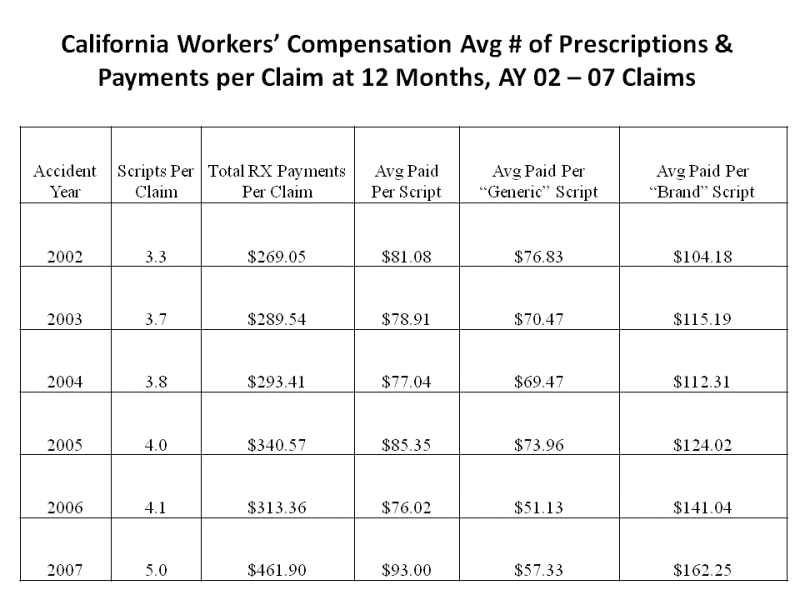Both the average number of prescriptions and total pharmaceutical payments per claim in California workers’ compensation are up sharply since 2002, despite medical reforms and the adoption of a pharmacy fee schedule — increases that coincide with the growing use and soaring cost of “brand” drugs and highly addictive “Schedule II” medications, according to a new California Workers’ Compensation Institute Research Update.
CWCI compared first-year prescriptions and pharmaceutical payments for accident year 2002-07 claims and found that the average number of prescriptions per claim rose steadily from 3.3 in AY 2002 to 5.0 in AY 2007, up nearly 52% over the six-year span. At the same time, average first-year prescription payments jumped from $269.05 to $461.90, or nearly 72% — an increase that is only partially explained by the increasing number of scripts per claim. Notably, the average amount paid for generics declined from 2002 to 2006, while average payments for “brand” medications rose nearly 56%, so the study ascribes the growth in total prescription costs to both increasing utilization and a shift toward more expensive brand medications. Overall, for the post-reform period of AY 2005-2007, the average number of first-year prescriptions per claim was up 25% while first-year prescription drug payments per claim rose 35.6%.
Taking a closer look at the changing mix of medications used to treat injured workers, the study identified a steady increase in the use of “Schedule II” medications – including oxycodone, fentanyl, morphine and short-acting barbiturates – controlled substances that the federal government says have legitimate medical uses, but which also have a high potential for abuse or addiction. The Institute data show the use of these drugs nearly tripled from 0.4% of the 2002 prescriptions to 1.1% of the 2004 prescriptions, fell back to 0.9% of the 2005 prescriptions (the first full year after SB 899 was enacted), then took a sharp jump in 2006, accounting for 1.3% of all prescriptions. That percentage more than doubled to 2.9% in 2007 and doubled again to 5.9% by the third quarter of 2008. At the same time that utilization of Schedule II medications was climbing, the average amount paid for these drugs was rising as well, with the average amount paid for a Schedule II prescription in workers’ compensation nearly tripling from $97.73 in 2002 to $279.75 in 2008. With both utilization and average reimbursements on the rise, Schedule II drug payments skyrocketed from 0.7% of California workers’ compensation prescription dollars in 2002 to 18% of prescription payments in the first three quarters of 2008.
The Institute study also took a look at the effectiveness of regulatory reforms enacted in 2007 to close a loophole that had allowed medical providers who dispensed repackaged drugs from their offices to obtain much higher payments than pharmacies for dispensing the same drugs. The Institute data show that in 2006 — just prior to the closure of the loophole — repackaged drugs represented well over half (54.7%) of all filled prescriptions and 59.2% of all prescription payments in California workers’ compensation; but by the mid-2007, repackaged drugs had declined to 10.5% of the prescriptions and 8.3% of the payments. Furthermore, those percentages continue to decline, with data for the first three quarters of 2008 showing repackaged drugs accounting for just 8.1% of workers’ compensation prescriptions and 5.8% of the pharmaceutical payments.
The Institute study shows that that even though reforms such as modified fee schedules and non-differential pricings for repackaged drugs have successfully curbed some of the excesses in California workers’ compensation, prescription drugs remain a key cost driver as the fluid nature of pharmaceutical pricing, new drugs, limited generic substitution, direct-to-consumer advertising, and lack of formulary controls limit the system’s ability to better control utilization and cost increases from year to year. In addition, the recent addition of a Pain Management treatment guideline to the Medical Treatment Utilization Schedule (MTUS) raises questions about the future use of pain medications and ancillary services. The Institute plans to conduct follow-up research next year which to measure the association between pain management protocols, changes in pharmaceuticals, the use of opioids and claim outcomes. In the meantime, the current study, “Changes in Pharmaceutical Utilization and Reimbursement in the California Workers’ Compensation System,” is available in the Research section of the Institute’s website at www.cwci.org.

